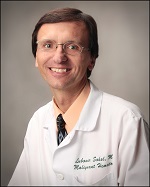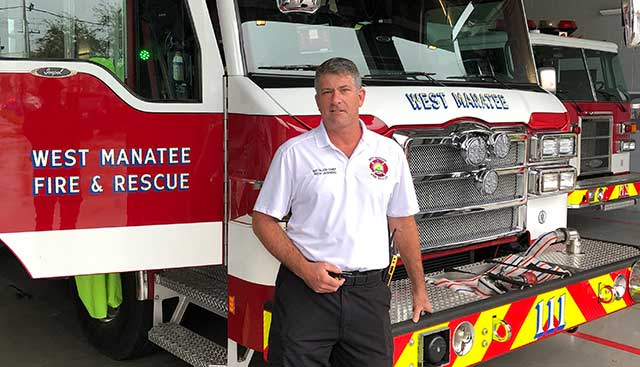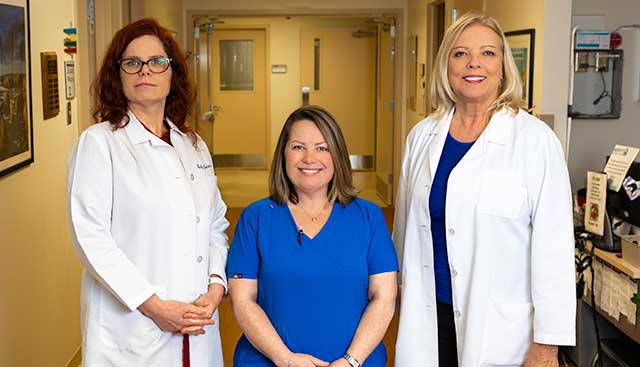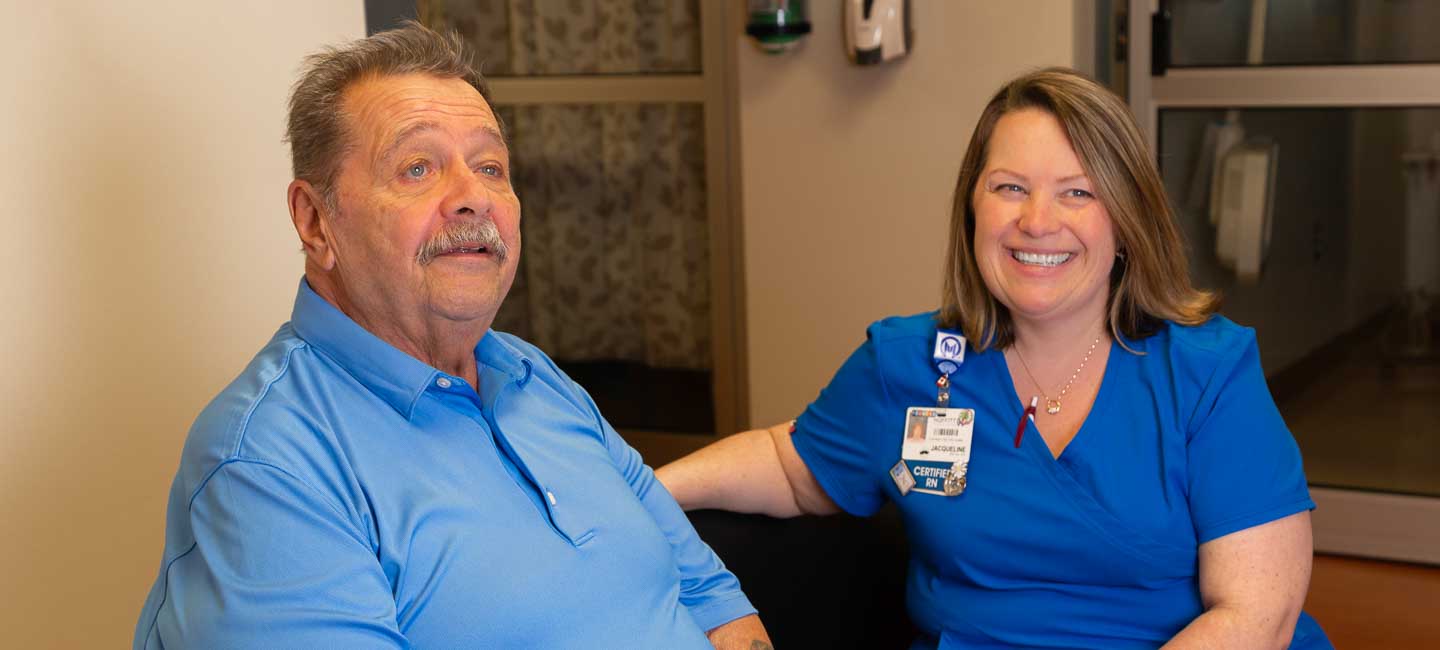Clinical Research Unit: A Source of Hope
WHAT IS HOPE?
Look online and you’ll find Dictionary.com defines it as “the feeling that what is wanted can be had or that events will turn out for the best.”
Look in Moffitt Cancer Center’s Clinical Research Unit (CRU), and you’ll find it in the work of a united team of nurses, patients, caregivers and loved ones doing whatever is necessary to transform hope into reality in the form of cures.
Dan Beres recalled being given three to four weeks to live after being diagnosed with a blood disease with a long name: blastic plasmacytoid dendritic cell neoplasm (BPDCN). The disease is tricky to diagnose, as it presents with features of both lymphoma and leukemia. There was no treatment at that time. Beres was told to go home and get his affairs in order.
A few days after his diagnosis, Beres was contacted by his medical team about a new trial of a drug called SL-401. For Beres, it was a dose of hope. He was able to transfer his treatment to Moffitt and enroll in the trial.
Three years later, Beres continues coming to Moffitt’s Clinical Research Unit for treatment under the care of Lubomir Sokol, M.D., Ph.D., a member of Moffitt’s Malignant Hematology Department.

Lubomir Sokol, M.D., Ph.D., Moffitt Malignant Hematology Department
Sokol notes that BPDCN is an aggressive, complicated disease, adding that he has seen massive skin tumors on patients with BPDCN melt away while on this treatment through a clinical trial. Beres notes he did not present with skin lesions, making his diagnosis more challenging.
“Before SL-401, patients with BPDCN who did not have a stem cell transplant died,” said Sokol. “SL-401 changed that.” Results of the phase 1 trial were promising; the phase 2 trial showed an overall response rate of 90 percent and a complete response rate of 72 percent. “Clinical trials are so important. For many patients, these studies can be their only hope.”
CRU SUPPORTS CLINICAL RESEARCH
The Clinical Research Unit (CRU) at Moffitt supports clinical investigational research by monitoring patients undergoing clinical trials and administering investigational agents in an outpatient setting. The CRU has locations at both Moffitt’s Magnolia and McKinley campuses.
Phase 1 and phase 2 trials requiring investigational treatments in all forms are administered in the CRU. The CRU is a self-contained treatment center in which most monitoring tests or procedures are performed on the unit. These include electrocardiograms, pharmacokinetic blood sampling and physical assessments.
The CRU sees 30 to 50 patients each day, and between 20 to 50 investigational treatments ranging from 30 minutes to 12 hours are conducted on the unit.
After three years of clinical trials, the drug Beres has been taking gained approval of the U.S. Food and Drug Administration in December 2018. Now marketed as ELZONRIS™, it is the first FDA-approved treatment for BPDCN. “Dan has been on this drug longer than any other patient,” says Bucky Jones-Lombard, RN, who manages the CRU. “We call Dan ‘The Mayor’ because his treatment cycle is every 21 days, so he is here Monday to Friday every three weeks.” Clearly a people person, The Mayor can be seen talking to fellow patients and their families and joking with the nurses. “After three years, I know most of the people here!”
Given how often he comes to the CRU, it’s no wonder Beres moved from Vero Beach to Tampa. “I got tired of driving three hours each way,” says Beres. The care has always been worth whatever travel was needed. “The nurses here are outstanding,” he says.
An avid traveler, Beres makes the most of the off weeks when he doesn’t receive treatment. He and his wife, Cindy, love to take cruises. “I’ve been to most of the Caribbean islands,” he says, noting that Aruba and Cozumel were his favorites. When he’s not cruising the islands or Moffitt’s CRU, The Mayor plays golf, goes to the health club regularly and makes the most of every opportunity to enjoy life and socialize.
“You’ve just got to stay active,” says Beres.
It seems the staff of the CRU has taken that advice to heart. “There now are more drug treatment options. Many of these trials are successful, as evidenced by Dan and others like him,” says Jones-Lombard. “Our challenge now is that there are many patients who are with us [in the CRU] for a long time. We are running out of space!”
INCREASING VOLUME AND COMPLEXITY
In her 14 years as a clinical research nurse administering treatments in Moffitt’s CRU, Jacqueline Pray, RN, said the growth in the number of patients has been the single biggest change. “The volume has increased exponentially, almost year over year.”
The nature of her work has changed as well, and that’s reflected in Pray’s job title. “Over the years we have gone from being called infusion nurses to treatment nurses in the CRU because what we do is not limited to infusion. Treatment can include oral medications, vaccines, all sorts of different things.”
Clinical research treatment nurses like Pray also are charged with managing increased complexity, starting with the patients themselves. “Today we are seeing much more complex patients, often after they have been through a number of treatments so they are depleted in a number of ways — a big difference from 2005 when I first joined,” said Pray.
Likewise, the studies also are more complex. “They used to be more straightforward. For example, we would have a pre-dose blood draw and then maybe two or three blood draws after the dosing,” said Pray. Today, it can involve a series of labs before dosing, electrocardiograms, use of multiple agents given by mouth or IV. And the whole scenario must be closely monitored with multiple blood draws through four, eight or even 12 hours of the day. Needless to say, Pray noted, “the labor intensity per patient has gone up.”
Through it all, Jones-Lombard said meticulous attention must be paid to every detail of the study requirements. “If trials are not done properly, the findings would be off,” she notes, “and if the drug were to be approved, it could be dangerous.” Jones- Lombard said the most unique challenge facing the clinical research treatment nurses is the unknown surrounding the drugs they administer. “Some of this is ‘first in human’ research; no other human being has received this drug before. So, you might think you know what could happen, but you really don’t. It requires a certain amount of bravery.”
For Pray and her colleagues, that bravery is rewarded by being on the cutting edge of the latest treatments. “We have been at the forefront of a lot of treatments that are now FDA standard treatment,” Pray said. It’s especially rewarding to see progress in patients who’ve been “regulars” in the CRU, some of them coming for years. “We get to know them intimately. We know their families, they know about our families,” said Pray. But such connection can also bring heartbreak. “When you become that close to people and things don’t go well for them, you can take it personally.”
AMONG THE COURAGEOUS
Compared to the bravery necessary for nurses to administer new drugs, the courage of CRU patients receiving them is remarkable, said Pray.
“Most of our patients have been through other standard-of-care treatments. Often, they have exhausted their options and a clinical trial is their only other option,” said Pray. “They are not ready to throw in the towel just yet. They are motivated and hopeful. I have a great deal of respect for people who are willing to basically step off a ledge and take a chance.”
That’s what Beres did, though he said his decision to participate in the clinical trial was pretty clear. “It was this or death — not much of a choice!” He would recommend a similar choice for other cancer patients considering clinical trials. “If you have this disease, you gotta fight it somehow. Sometimes traditional things don’t work.”
Beres was quick to add, “This may not help me, but maybe the information you get from me taking this drug is going to help somebody else months or years down the line.” It’s a thought Pray said she has heard countless times from other patients.
“Some of these patients are doing this knowing they may not have a lot of time,” said Pray, “yet they are still willing to give us their time for the possibility that they may help somebody else in the future. It’s incredibly generous and courageous and inspiring.”
“Clinical studies — especially the phase 1 studies — are very important,” said Sokol. “There are so many more drugs available today compared to more than 10 years ago.” He cited the example of the drug Gleevec used to treat certain types of leukemia and other cancers. “We never knew it [Gleevec] would be such a success.” In the late 1990s when a study of Gleevec in patients with chronic myeloid leukemia was conducted, the patients who did not participate in the clinical trial could receive interferon, which improved survival, so not all patients ultimately had to die. If the patients responded to interferon, they could be switched to Gleevec after the drug was approved in 2001 and possibly become cured.
A 10-YEAR LIFESAVER
As battalion chief of the West Manatee Fire Rescue, Richard Jasinski has devoted his life to saving the lives of others.


Diagnosed with Hodgkin lymphoma, Jasinski endured several treatment regimens including a stem cell transplant, but ultimately relapsed. An experimental drug called conatumumab has kept him alive for the past 10 years.
“Had the doctor not recommended that trial, I don’t know where I would be today,” said Jasinski.
Jasinski began treatment with conatumumab in December 2008. As of February 2019, he has had 131 cycles of the drug with no relapse. “I’m blessed every day to be on it,” he said.
“In his case, we were performing personalized medicine by chance,” said Sokol. “Ten years later, we know so much more about targeted molecular therapy that we can attempt to find personalized therapy for individual patients. We need to outsmart the cancer through biologic or targeted therapy. And in some patients, like Rich Jasinski and Dan Beres, study treatment through a clinical trial can be a lifesaver.”
Jasinski remains hopeful. “A lot of people hear the word ‘cancer’ and think it is the end of the world, but it is not a death sentence by any means. There are so many treatments out there for a variety of things. Getting plugged in with the right doctor and the right facility is essential.”
CLINICAL RESEARCH NURSES TREAT THE WHOLE PERSON
Clinical research treatment nurses like Pray tend to the patients throughout their trials while in the CRU. But it takes a different kind of nurse to get them through the door. Clinical research nurses like Elyce Turba, RN, help to get the patient on the trial and to overcome obstacles along the way. “I like the excitement of [working in] hematology clinical trials,” said Turba. “Something new happens every day.”


Although Turba has been with Moffitt for 10 years, clinical research nursing just became a specialty in October 2016. Clearly proud of her profession, Turba says she wants people to know that clinical research nurses treat and care for the whole person. “We aim to be aware not only of the safety of the patients while they are on the clinical trial, but also their spiritual needs, their emotional needs, their social needs — those are the kinds of issues that we are trained to handle on a daily basis.”
Clinical research nursing comprises five separate, yet overlapping, domains:
- Human subject protection
- Care coordination and continuity
- Contribution to the science
- Clinical practice
- Study management
Within these five domains, clinical research nurses focus on maintaining equilibrium between the care of the patient and the integrity of the protocol.
CRU nurses like Pray focus on clinical care and coordination of care. “So we work hand in hand with the CRU team,” said Turba, “as well as in a collaborative nature with the other members of the research team.”
Turba has witnessed positive changes over her 10 years at the cancer center, including better processes like the FDA’s “fast track” efforts to speed some of the newer drugs to market. This is especially helpful when there are limited drugs available for a particular disease.
“It is very detailed; but now that the FDA has set up a process whereby they can expedite drugs that have shown promise and for diseases that have few available treatments, it is extremely encouraging,” said Turba. “Hematology includes a number of rare diseases. It takes a long time to find enough of these patients in order to do a trial with statistical significance at the end.”
Turba said the best part of her “dream job” is seeing FDA approval of a drug that was studied through clinical trials here at Moffitt in patients she has come to know and respect.
The biggest challenge she has seen is the cancer center’s rapid growth. “I want to treat and enroll as many patients as I can on clinical trials, and sometimes we are limited by space,” she said. “I happened to hear Mr. [H. Lee] Moffitt at a Speak Out for Moffitt meeting say that thousands of new patients a year come to Moffitt for treatment. But we basically have the same facilities. When I heard Mr. Moffitt say ‘we’re out of space,’ I thought, ‘Wow! Did he ever dream that this would happen when he came up with the concept of a cancer center in Tampa — that the growth would be so fast?’ ”
Clearly, hope is in high demand. And through its clinical research efforts, Moffitt will continue doing all it can to deliver.
Editor’s Note: In Fiscal Year 2018, Moffitt saw 23,199 new patients and had 406,117 outpatient visits.


